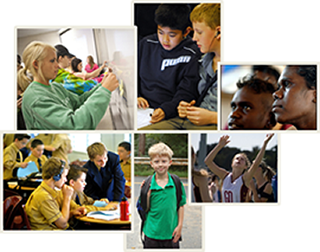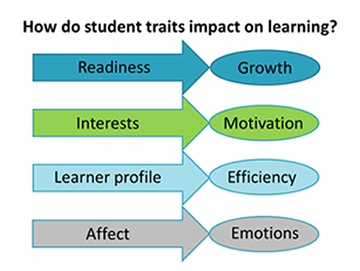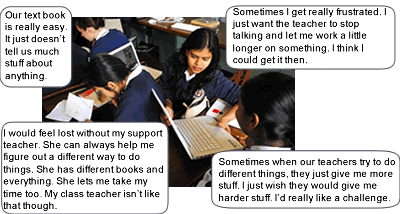Know your students and how they learn

Teachers need to know more than just the academic performance of their students in order to effectively differentiate. According to Tomlinson (2004):
To teach most effectively, teachers must take into account who they are teaching as well as what they are teaching. The goal of the differentiated classroom is to plan actively and consistently to help each learner move as far and as fast as possible along a learning continuum.
Consider the following descriptors from the Australian Professional Standards for Teachers, Standard 1 Know students and how they learn at Proficient level.
-
Use teaching strategies based on knowledge of students’ physical, social and intellectual development and characteristics to improve student learning (1.1.2)
-
Design and implement teaching strategies that are responsive to the learning strengths and needs of students from diverse linguistic, cultural, religious and socio-economic backgrounds (1.3.2)
-
Design and implement effective teaching strategies that are responsive to the local community and cultural setting, linguistic background and histories of Aboriginal and Torres Strait Islander students (1.4.2)
-
Develop teaching activities that incorporate differentiated strategies to meet the specific learning needs of students across the full range of abilities (1.5.2)
-
Design and implement teaching activities that support the participation and learning of students with disability and address relevant policy and legislative requirements (1.6.2).
|
|
Activity 2: The learner – Know my students and how they learn Reflect on your understanding of the importance of factors which influence student learning. |
Using data to inform teaching and learning
The information and data we gather about our students must relate to what teachers are teaching and students are learning. If we wish to enhance teaching and learning the location of ‘evidence’ starts in the classroom. According to Masters (2013):
Once it is recognised that the fundamental purpose of assessment is to establish where students are in their learning (that is, what they know, understand and can do), many traditional assessment distinctions become unnecessary and unhelpful.
Judgements about where students are in their learning can be made a number of ways for different purposes. These include:
-
assessment of, for and as learning – see Aspects of Assessment from the Strong Start, Great Teachers website
-
employing norm-, standards-, criterion- and self-referenced methods.
|
|
Read Towards a growth mindset in assessment and reflect on how assessment and reporting processes shape student, parent and community beliefs about learning. |
Student learning profile
Carol Ann Tomlinson suggests there are four key aspects of a student’s learning profile that teachers must address to ensure effective and efficient learning.
 |
Refers to students’ knowledge, understanding and skills related to a sequence of learning. Readiness is influenced by prior learning, life experiences and attitudes to school. It requires a balance between a level of difficulty which is challenging and yet attainable for the student. Readiness differs from ability. Refers to activities which tap into students’ curiosity and passion to learn. When students are interested they are willing to invest time and energy to learn new skills and concepts. Teachers identify the interests that students bring and introduce them to new interests to encourage engagement and persistence in learning. Students learn differently. The way a student learns best is determined by a combination of many factors including learning style, culture and gender. Providing various modes of learning within the classroom will result in effective learning for more students. Refers to how students feel about themselves and their learning, their emotions and the teaching and learning environment. When students feel secure, safe, comfortable and supported within a learning environment they are more likely to attain their cognitive potential. This course incorporates Affect into the Learning environment element. (Learning environment is explained in the tab Differentiation in practice.) |
The purpose of ascertaining readiness is to understand the entry points of students into the content. Students may enter the learning above, below or at stage level. Their strengths and needs, connections with prior knowledge, social and cultural background knowledge and the classroom context all need to be considered.
Watch this video of Tomlinson discussing Readiness on Differentiated Instructions.
|
View the graphic and discuss:
|
 ©Text Tomlinson (1995) Image torres21 CC BY-SA 2.0 |
Data conversations
Schools accumulate large amounts of data unique to each student. Key people, groups and teams are responsible for gathering and managing this data. Teachers need to know what data is available and how to transform it into information which is useful for engaging in data conversations to inform educational practice.
|
|
Activity 3A: Identifying student data to inform practice All schools have access to data regarding the social, academic, emotional and personal learning needs of students. Schools manage this information in different ways. Identify all forms of student data available in your school and who you need to see for access. |
Interrogating school data
Data can be used by teachers to inform planning and improve the educational outcomes of all students.
The following expandables demonstrate ways to interrogate and manage data to better understand your students’ needs:
|
|
Alexandra Slee, K-2 Curriculum Advisor, Early Learning and Primary Education Unit, demonstrates how to interrogate Planning Literacy and Numeracy (PLAN) data to inform students’ literacy and numeracy needs at whole school, class and individual student levels: |
|
|
In Analysing NAPLAN numeracy data within SMART, Kerrie Spencer, Teacher, Jannali Public School, interrogates NAPLAN data to discover the identified needs of learners in a Year 5 maths class. |
|
|
In Analysing NAPLAN and ESSA literacy data within SMART, Martin Lauricella, Head Teacher Science, Canterbury Boys High School, analyses:
within the School Measurement Assessment & Reporting Toolkit (SMART). |
|
|
In Using data to differentiate – Student wellbeing data, Warren Parkes, Principal, Robert Townson High School, analyses school wellbeing data and provides differentiated strategies. |
The following resources have been developed by schools to assist with the collection and management of student data.
-
Alexia Martin, Head teacher, Asquith Girls High School, has developed a Student data analysis tool (.xlsx 73kB) that allows her to collate data from various sources.
-
In the online presentation Every School, Every Student Support Tool Jennifer Reeves, Principal, Muirfield High School, explains how to use the support tool (.xlsx 20kB) to explicitly document adjustments made to the learning environment, content, teaching strategies and assessment strategies for students.
|
|
Activity 3B: Interrogating sample student data Choose one of the examples provided in the Activity booklet and interrogate the data to identify students’ needs. |



